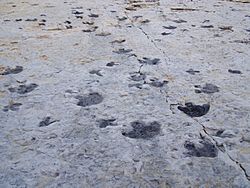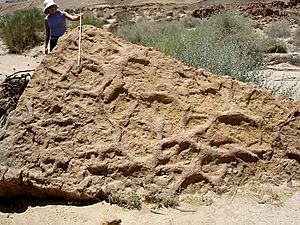Ichnology facts for kids


Ichnology is the study of trace fossils of once-living things.
Burrows, trackways, trails and borings are all examples of traces made by organisms. Scientists study traces made by plants and animals to try to determine their behavior. An ichnologist is a scientist whose area of study and research is ichnology.
A species name given to a fossil is called an ichnospecies. It is written in italics with a lower case initial. It is shown to be an ichnospecies by the abbreviation "isp".
Examples
- Later Cambrian trace fossils from intertidal settings include Protichnites and Climactichnites, and others.
- Mesozoic dinosaur footprints including Ichnotaxon such as Grallator and Atreipus (bipedal theropods) and Anomoepus.
- Triassic to Recent termite mounds, which can be several square kilometers of sediment
- Possible Avian footprints such as Saurexallopus.
Images for kids
-
Chirotherium footprints in a Triassic sandstone
-
Cross-section of mammoth footprints at The Mammoth Site, Hot Springs, South Dakota
-
This coprolite shows distinct top and bottom jaw bite marks, possibly from a prehistoric gar fish. Discovery location: South Carolina, US; age: Miocene; dimensions: 144.6mm X 63.41mm or 5.7” X 2.5”; weight: 558g (1lbs 4oz)
-
Petroxestes borings in a hardground from the Upper Ordovician of southern Ohio
-
Rusophycus trace fossil from the Ordovician of southern Ohio. Scale bar is 10 mm.
-
Trypanites borings in an Upper Ordovician hardground from northern Kentucky. The borings are filled with diagenetic dolomite (yellowish). Note that the boring on the far right cuts through a shell in the matrix.
-
Ophiomorpha and Thalassinoides trace fossils produced by crustaceans found at Camacho formation from the Late Miocene in Colonia Department, Uruguay
-
Asteriacites (sea star trace fossil) from the Devonian of northeastern Ohio. It appears at first to be an external mold of the body, but the sediment piled between the rays shows that it is a burrow.
-
Numerous borings in a Cretaceous cobble, Faringdon, England; see Wilson (1986)
-
Entobia from the Prairie Bluff Chalk Formation (Upper Cretaceous). Preserved as a cast of the excavations.
-
Helminthopsis ichnosp., a trace fossil from the Logan Formation (Lower Carboniferous) of Wooster, Ohio
-
Lockeia from the Dakota Formation (Upper Cretaceous)
-
Lockeia from the Chagrin Shale (Upper Devonian) of northeastern Ohio. This is an example of the trace fossil ethological group Fugichnia.
-
Inverted trace fossil of an unidentified tridactyl ornithopod
See also
 In Spanish: Icnofósil para niños
In Spanish: Icnofósil para niños



























